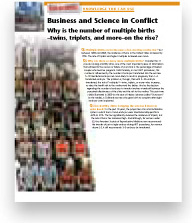CONTENTS
|
From two parents to one embryo to one baby |
|
|
How do animals reproduce? 1004 |
|
|
25.1 |
Reproductive options (and ethical issues) are on the rise. 1004 |
|
25.2 |
There are costs and benefits to having a partner: sexual versus asexual reproduction. 1005 |
|
25.3 |
Fertilization can occur inside or outside a female’s body. 1007 |
|
Male and female reproductive systems have important similarities and differences. 1010 |
|
|
25.4 |
Sperm are made in the testes. 1010 |
|
25.5 |
There is unseen conflict among sperm cells. 1013 |
|
25.6 |
This is how we do it: Can males increase sperm investment in response to the presence of another male? 1014 |
|
25.7 |
Eggs are made in the ovaries (and the process can take decades). 1016 |
|
25.8 |
Hormones direct the process of ovulation and the preparation for gestation. 1018 |
|
Sex can lead to fertilization, but it can also spread sexually transmitted diseases. 1022 |
|
|
25.9 |
In fertilization, two cells become one. 1022 |
|
25.10 |
Numerous strategies can help prevent fertilization. 1023 |
|
25.11 |
Sexually transmitted diseases reveal battles between microbes and humans. 1025 |
|
Human development occurs in specific stages. 1027 |
|
|
25.12 |
Early embryonic development occurs during cleavage, gastrulation, and neurulation. 1027 |
|
25.13 |
How does an embryo become male or female? 1030 |
|
25.14 |
There are three stages of pregnancy. 1032 |
|
25.15 |
Pregnancy culminates in childbirth and the start of lactation. 1034 |
|
Reproductive technology has benefits and dangers. 1036 |
|
|
25.16 |
Assisted reproductive technologies are promising and perilous. 1036 |
|
Business and science in conflict: why is the number of multiple births— |
|
XXIX
 25 • Reproduction and Development 1003
25 • Reproduction and Development 1003 StreetBIO: KNOWLEDGE YOU CAN USE
StreetBIO: KNOWLEDGE YOU CAN USE